Background
Natural conditions play a decisive role in the development of malaria1,2. Annual average temperatures of at least 18°C (64.4°F), which promote Plasmodium's parasitic cycle within the mosquito3, and frequent and sufficient rainfall, which rejuvenates stagnant waters and provides preferential larval breeding grounds for Anopheles, both have a significant impact on incidence. These characteristics are present in large areas of the tropics, suggesting that malaria risk within the same zone is not spatially equidistributed. Predictive models of high-risk malarial areas have mainly been developed on the basis of climatic variables. The seasonality of rainfall, minimum temperature, and type of irrigation allow the seasonality of the entomological inoculation rate (EIR) to be determined4. However, since temperatures are consistently high (an average of 25°C (77°F)) in tropical regions, rainfall is the most significant determinant of the seasonality of malaria. Nevertheless, analysis at the local (or even micro-local) scale is essential to accurately determine the distribution of malaria risk; important differences in the intensity of transmission exist even at very small scales5.
More recently, Cottrell et al6. have highlighted that local environmental factors are important in determining malarial transmission on a small scale. However, few models account for spatial heterogeneity of malaria risk within and between the impacted territories and the characteristics of the populations living in these areas. Most of the existing literature links malaria to the environment by way of natural factors, often exclusively climatic, capable of generating the existence of biota favourable to the larval development, such as the presence of stagnant water. However, since the early 2000s, the focus has shifted to the analysis of the land cover in the immediate vicinity of living areas (particularly agricultural practices) using multispectral satellite images and integrating data related to households and housing construction materials into geographic information systems (GISs)7. It remains a challenge to make accurate predictions of vector proliferation on the basis of physical and biological environmental factors alone8. It is necessary to consider the environment in its totality by looking beyond traditional fragmentation of social and natural characteristics within territories. It has been shown that anthropogenic factors are important for the generation of vector shelters close to areas where people live9. Associations between risk of malaria and different types of construction have been highlighted in Sri Lanka, where it has been shown that there is an increased incidence of malaria among residents of more modest homes, where a higher number of anopheles have been recorded10. This suggests that a plausible link exists between social factors and vulnerability to malaria, but all the contributing factors are yet to be defined.
Several recent studies have renewed interest in measuring the impact of the social determinants that alter a population's vulnerability to the vector. These studies have analysed the importance of socio-environmental malarial risk factors in urban zones11,12 or highlighted the impact of agricultural practices on vector proliferation in urban areas13. According to WHO, the social determinants of health correspond to the conditions in which people are born, grow, live, work and age and are primarily responsible for health inequalities. These conditions are determined by the distribution of money and resources at different scales. With respect to malaria, some Asian studies have proposed a link between malaria risk and poverty indicators: deprived communities in Rajasthan (India), for example, seem to be three times more susceptible than more developed communities in the same sector, possibly because of differential knowledge of risk factors14. In the same way, the presence of forest cover and indicators of poverty have been associated with increased malaria incidence rates in Vietnam15. More recently, a meta-analysis by Tusting et al16. has reiterated the link between low socioeconomic status and malaria at a sub-urban scale. This study highlights that wealth is probably protective against malaria by increasing, for example, housing quality, which leads to a decline in the inflow of potential vectors at the fine scale of the household. When the quality of the household is precarious (small dark homes, straw roofs and earthen walls), the endophilic character of Anopheles gambiae is promoted and this impacts on vector densities in and around these constructions9.
Objectives
The comprehensive characterization of small-scale larval habitats or mosquito resting sites has historically required intensive fieldwork. Here was proposed a photography-based approach to capture quickly the living conditions of a number of concessions. This approach results in a single short visit that is minimally invasive for families participating in a research program. This approach echoes the Photovoice methodology17, in which people use images or videos to describe and share the characteristics of their environment. Photovoice has led, for example, to the identification of socio-environmental determinants of HIV risk among African-American teenagers18 or the characterization of behavioural risk factors for diarrhoea in Tanzania19. This study shares a common goal with Photovoice, namely the characterization of an environment by photography. However, the methodology is based on a single visit and differs from Photovoice in that the photographs taken are dictated by a set of predefined items in an analysis grid to identify the breeding and resting sites of vectors and classify households in order to establish associations with entomological data.
The focus was primarily on the socio-economic factors determined by habitat types and livelihoods. It is hypothesised that certain habitats, dictated by the housing environment and living practices of its occupants, provide optimal conditions for the completion of the phases of the gonotrophic cycle and will therefore attract more mosquitoes. In other words, is there a link between different living conditions and the abundance of Anopheles gambiae in rural Benin? This study, which has to be considered a pilot, is currently limited by the very small study sample; it cannot be claimed that the sample is representative of the whole studied area. Nevertheless, the coded items within the study seem to encompass a large diversity of household/habitat types and modes of living. This pilot work paves the way for the effective study of links between housing environments, ways of life and vector proliferation.
Overall study design, study area and context
This pilot study is part of a multidisciplinary research program called Tolimmunpal, which involves general practitioners, epidemiologists, biologists, biostatisticians, entomologists, geneticists and geographers. Based on a two-year prospective follow-up cohort study of 400 pregnant women-child pairs, this program aims to establish the determinants (environmental, biological and genetic) involved in the development of immune tolerance to malaria in a rural region in southern Benin. Clinical, parasitological and biological data have been collected together with environmental and entomological information.
In order to successfully identify the biological or genetic determinants related to immune tolerance responsible for variations in susceptibility to malaria, it is also essential to take into account the behavioural and environmental factors that might influence susceptibility. Environmental and health data will eventually be integrated in a GIS to generate a comprehensive predictive model of vector proliferation. However, this study is a first step designed to evaluate the impact of the environment - in its broadest sense - on vector proliferation on 64 equally distributed concessions. Environmental factors are defined as characteristics of small-scale households in order to highlight points of convergence and divergence in livelihoods and living practices. This analysis will eventually be extended to include all homes hosting 'mother-child' couples living in the Allada territory of Benin (30 km by 30 km). Allada is a small town in southern Benin20, located in the north of the Atlantique department, about 56 km from the economic capital of Benin (Cotonou). In the subequatorial zone, Allada receives an annual average rainfall of 1-1.5 m between April and July and between the middle of September and the end of November. The dry season, from December to March, explains a seasonal decrease in the rate of malaria.
Household environment: Coding types of housing and ways of life using an itemised list is reported in an analysis grid. The social determinants that facilitate the presence of mosquitoes in the housing environment were first studied. The presence of Anopheles can be explained by two essential needs of the mosquito: feeding and reproduction. This behaviour coincides with the three phases of the gonotrophic cycle. The spatial heterogeneity of host-vector contact depends on the way in which land is used. The presence of humans, the existence of rest sites, and the availability of egg-laying sites are some of the principal reasons why mosquitoes settle in certain places. Human presence can condition vectors' choices9.
An analysis grid was designed that listed predefined variables relating to lifestyle and other characteristics of the home environment that were potentially related to vector proliferation (Fig1), in connection with the essential needs of the mosquitoes (bite, egg-lay and rest). This grid was designed to support careful and systematic interpretation of the photographs and considers:
- population density ('number of people sleeping in the household' and 'isolated or grouped homes')
- potential egg-laying sites in terms of the availability of stagnant water. Grid variables included latrines, showers, rainwater recycling systems, hollow objects, palm factories, uncontrolled dumpsites, kitchen gardens, tanks and asperities in the ground (Fig2)
- potential resting sites and building materials. The different combination of building materials (Fig3) and potential rest sites (Fig4) were then highlighted and coded.
These items were then searched for in a corpus of photographs taken at each of the 64 concessions. Each concession was analysed using this grid to characterise the presence or absence of these items. These data were then used to characterise each household by calculating the percentage of occurrence of each item.

Figure 1: Types of housing environment and living practices: explanatory variables of small-scale differential vulnerability.
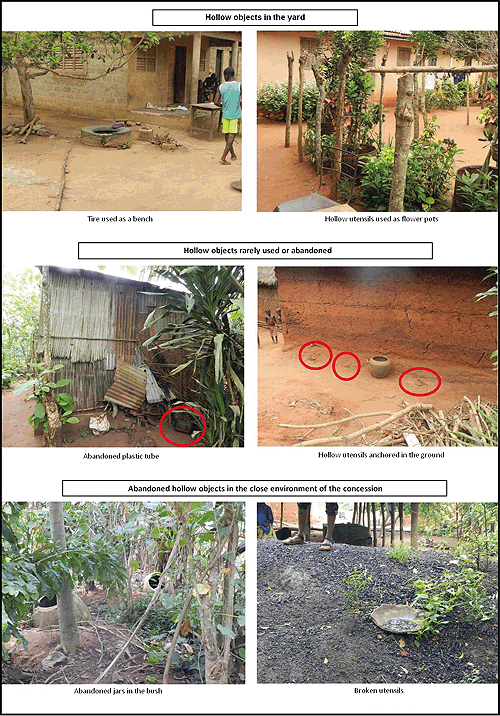
Figure 2: Examples of hollow objects likely to serve as vector-breeding sites.
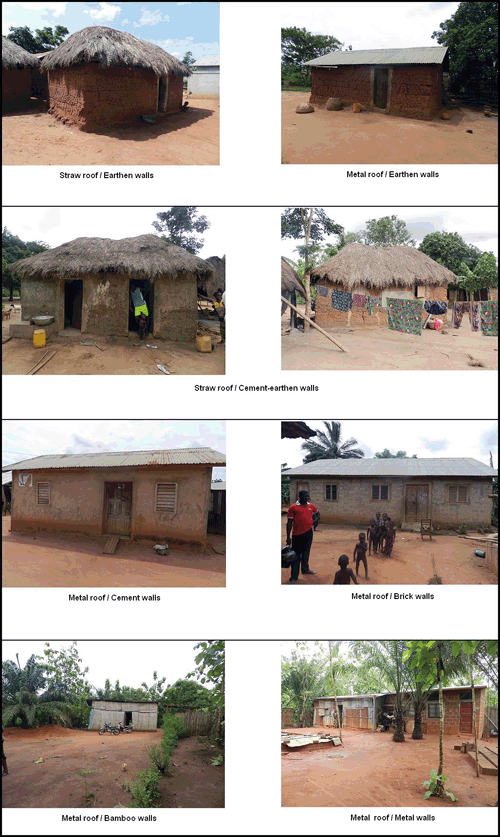
Figure 3: Diversity of the building materials used in the houses where mosquitoes were captured in the region of Allada.

Figure 4: Potential rest sites for mosquitoes in the yards of homes.
Taking photographs to interpret reality
The housing environment was investigated by using photography. Usually, vector-borne disease studies focus primarily on biomedical data. Social analyses generally follow as a second step. The development of an indirect method of data acquisition by using photography allows remote batch processing by specialists in the humanities, reduces the number of researchers in the field, and permits the application of both biomedical and human approaches at the same time. Photographs, (5-10, depending on the size of the concession) were only taken at sites where mosquitoes were captured. This facilitates ongoing work aiming to show a possible relationship between household types, their livelihoods, and the proliferation of Anopheles.
The photographer first took a general panoramic photograph of the courtyard home before taking close-up photographs of every element related to the predefined study variables. It was also important to photograph all the sides of the house in order to collect comprehensive information about the building materials used in the walls and roofs and the number of openings such as windows, doors and air vents. The close neighbourhood of the houses was also photographed in order to assess the immediate surrounding environment. Photos were taken in landscape format to better represent the human field of view and highlight small objects. Lastly, the field researchers noted the geographical coordinates of the concession for possible future integration using a GIS, where these photographs could also be imported for a diachronic survey. In this way, characterization of the presence or absence of predefined items in each concession was used to determine household profiles that could be linked to entomological data according to hypothetical-deductive reasoning.
Entomological data
The entomological data relied on mosquito catches in 180 of the 400 children's bedrooms assessed in the program. It was physically impossible to follow the 400 houses. A selection of 180 bedrooms was made on the basis of geographical equidistribution criteria. CDC (Center for Disease Control) light traps were used on two consecutive nights per month between April 2011 and February 2013. The traps were installed at dark and collected at dusk. All mosquitoes were brought to the laboratory for identification (genus and species) and all Anopheles mosquitoes were kept individually for further analysis. Of the 64 concessions included in this study, the final focus was on the 51 concessions for which at least 22 nights of catches were available over a full year (a loss of two nights per year was allowed in order to maintain a sufficient number of homes for analysis). For each of these 51 concessions, the average number of Anopheles gambiae captured per night was calculated.
Statistics
A statistical analysis of habitat elements or livelihoods was carried out for the 64 concessions. First, an exhaustive survey of the presence or absence of each item listed in the grid was conducted. Then, the most frequent items in the territory studied were calculated using percentages to highlight the most discriminating elements. An overview of the coded concessions led to three classes of household being distinguished.
The average number of Anopheles gambiae captured per concession type was calculated. The association between these household types and the average number of Anopheles was analysed by the Kruskal-Wallis test, and analysis of covariance (ANCOVA) was performed to highlight relationships between the average number of Anopheles captured per night and the building materials used. Finally, the Pearson correlation coefficient was used to correlate the number of potential breeding sites and the average number of Anopheles caught. All analyses were carried out using XLSTAT v7.5 (Addinsoft, 2012, www.xlstat.com/en).
Ethics approval
The protocol was approved by the Beninese Ethical Committee of the Faculté des Sciences de la Santé (FSS) and the IRD Consultative Committee on Professional Conduct and Ethics (CCDE).
General characterization of the analysed concessions and elements for typology
The detailed analysis of the photographic corpus using the items in the analysis grid revealed both shared and dissimilar elements between the concessions. This preliminary analysis allowed us to highlight the most discriminating features of the study area.
Table 1: Descriptive statistics of variables related to the households
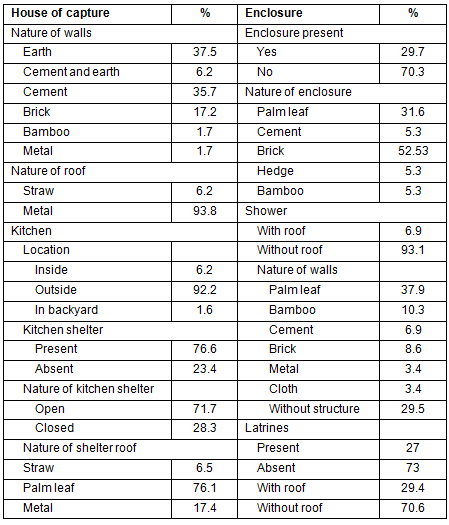
Table 2: Descriptive statistics of variables related to living practices in the region of Allada
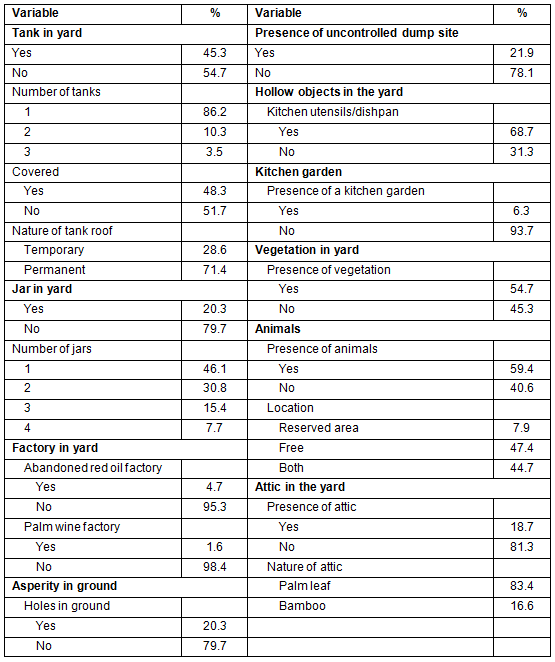
The most shared habitat elements in the 64 concessions were: the presence of a metal roof on the house (93.8%), absence of an enclosure (70.3%), a low number of discharges (uncontrolled dumpsites) (21.9%), the presence of attics (18.7%) and a low proportion of palm wine factories (1.6%) or palm oil factories (4.7%) (Tables 1,2). Similarly, certain living practices were quite common. Over two-thirds of the families left their kitchen utensils in the courtyard, which was unsurprising since the courtyard outside the home was generally used for cooking. Simple agricultural practice was rare in domestic areas. Only 6.3% of households had a kitchen garden. Crops were mainly found in the immediate surroundings around the homes but only 10% of households had cultivated fields immediately around their house. Over half of the families left the vegetation growing in their yard. The presence of banana trees in residential areas, in almost half of the households that had a garden, was particularly noted. The trees were generally found in isolated clumps and even when the household did not have a tree in their yard, it was very rare not to find at least a few banana trees in the vicinity of the house. It was common practice (92.2%) to cook outside in the courtyard with fire. When it rained, those without a shelter cooked inside their home. Open shelters with straw roofs were the most common. The showers were located outside in the courtyard, and were mostly roofless (93.1%) and made of palm leaves (37.9%).
In contrast to these widely shared characteristics, other household elements and living practices differed. Differences in the equipment level and the quality of the materials could potentially reflect the income level of the residents. For example, there was a clear distinction between concessions equipped with tanks (45.3%) and others. In the absence of an individual water supply in the concession, inhabitants had strategies to keep the rainwater but this kind of equipment is expensive and must therefore frequently be mutualized. In the same way, the construction materials used for the walls had variable characteristics. Houses made out of cement or brick were slightly better represented in the sample than those made of earth: 35.7% of walls were made of cement, 17.2% of brick and 37.5% of earth. Finally, two major types of dwelling were present in Allada: cement/brick or earthen houses, with cement or brick walls potentially reflecting less precarious households.
The different level of equipment led to three major habitat types being distinguished in the study area. Two extreme types could clearly be distinguished: type 1, very precarious with modest construction materials; and type 3, with hard construction materials, enclosed spaces, and covered water points. An intermediate type (type 2) was also apparent, which possessed a combination of several types of modest materials such as straw or hard (such as brick), with open spaces and uncovered water points.
Detailed analysis of the three types of concessions
The frequencies of each type of equipment per household type were summarized (Table 3). The first household type (n=28) is most precarious in terms of habitat type and lifestyle. It is generally defined by the combination of an earthen house with a metal roof, a shower without walls, and a shelter for cooking. The main building materials are palm leaves for the fence and straw for the roof of the kitchen's shelter. This type is also characterized by the opening up of living spaces, which can increase vulnerability to mosquito bites. The courtyard home has very few amenities: rarely a tank (29%), no visible latrines and jars being used to recycle rainwater. This type seems to be a fertile ground for the growth of mosquito larvae, but there are a smaller number of egg-laying sites due to the absence of certain kinds of equipment, such as a tank or a latrine. In contrast, there are resting sites, since the most commonly used building materials are earth, palm leaves and straw. Palm-leaf shower walls, a home's earthen walls and the kitchen's straw roof can be good repositories for mosquitoes.
Table 3: Percentages of equipment per household type
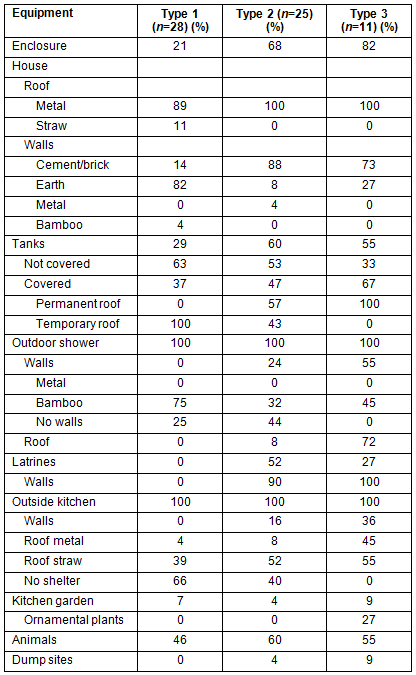
The second household type (n=25) tends to be associated with wealthier families; 68% of the concessions are fenced by walls or hedges. Houses with hard wall materials (92%) are all covered with metal roof. A total of 60% of these concessions have tanks, the majority uncovered (64%). A small majority of these concessions are visibly equipped with latrines (52%). Type 2 appears to be the household type that is more conducive to the development of vectors. The presence of open tanks, latrines, roofless showers and kitchen utensils in the courtyard leads to an abundance of mosquito resting sites. Families living here would be more vulnerable to vector bites because the majority of living places (eg kitchen, shower, toilet) are open.
The third household type (n=11) refers to a higher socioeconomic level of living; 82% of these concessions are enclosed by a fence. These exterior walls insulate the courtyard of the concessions, sometimes planted with ornamental species, from the public space. Houses with metal roofs are mostly made of hard materials (73%). A total of 55% of these households are equipped with one or two tanks covered permanently in 67% of cases. The outdoor showers are mainly walled (55%). Outdoor kitchens are all equipped with metal or straw roofs. Type 3 households seem less favourable to the development of vectors because the possibility of resting or egg-laying sites is smaller. Therefore, the walls of various elements of the home may not be conducive for the vector to rest. The living spaces are also closed off. Showers, latrines and tanks cannot be used as egg-laying sites because they have roofs.
Household types or their components and entomology
A first analysis of the average number of mosquitoes caught per night in each of the household types did not reveal a relationship between the number of mosquitoes and the social and material characteristics of the households. Based on the analysis of 51 concessions, the average number of mosquitoes captured per night was 0.55 in type 3, while the numbers were 0.88 and 0.85 mosquitoes/night for types 1 and 2, respectively, but these differences were not significant (Kruskal-Wallis test; p=0.41). An analysis combining types 1 and 2 (characterized by comparable anopheline densities) does not lead to more significant differences.
As well as categorization into three classes, a number of potential breeding sites were calculated for each concession, which corresponded to the sum of the number of jars, tanks, latrines, showers, and oil or palm wine factories in and around the concession. Analysis of correlation between the average number of Anopheles gambiae and the number of these potential breeding areas was not significant (r=-0.09, p=0.5).
Finally, a multivariate linear regression (ANCOVA) was performed to investigate the importance of the household materials and the number of openings on the average number of Anopheles captured per night. The results did not show any association between potential explanatory variables and the number of Anopheles captured per night (Table 4).
Table 4: Relation between the mean number of collected Anopheles and the covariates (multivariate regression)
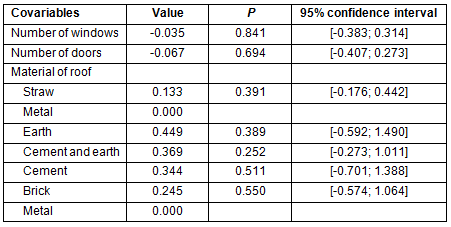
Discussion
This study attempted to identify the contribution of social and environmental factors to the risk of malaria associated with vector proliferation, which an analysis of the natural environment alone only partially explains. The way in which humans occupy the environment has resulted in a more comprehensive definition of 'environment' as 'the natural environment but also the environment built by humans'21. Etymologically, 'environment' is what is 'around' or what 'accompanies'. If the physical environment sets the context of what accompanies us, our anthropogenic creations also 'surround' us.
The analysis of living spaces using photography of 64 dwellings revealed three main types of household and living practices near Allada, where there is a diversity of habitat types and lifestyles. Mosquito control campaigns have shown that poorer lifestyles generate a malaria risk, since they tend to contain more areas with stagnant water and potential resting sites. This study, which has to be considered a pilot, is currently limited by the very small study sample; the sample cannot be claimed to be representative of the whole studied area. Nevertheless, the diversity of coded items within the study seems to encompass a large diversity of household/habitat types and modes of living.
The use of photography to capture the characteristics of neighbourhoods is not without limitations. The housing environment in Allada is very compact and it was therefore sometimes difficult to take pictures around certain houses since the photographer needed to invade the intimate space of other families whose houses did not form part of the study and who did not sign the initial consent form. It would also be desirable to analyse the elements of the environment close to the home by showing them together with the house, so that the distance separating them can be assessed. The development of the analysis grid is time-saving for research teams, and can be completed by the team in conjunction with the cohort. It can also be completed by geographers remotely who therefore do not necessarily have to be present when the digital photographs are transmitted via the internet. However, this approach can generate some interpretation bias: can the absence of animals in a photograph be generalized? Is a tank always or temporarily covered? Is it a jar or a kitchen utensil? Is it an earthen wall or mixed with cement? Only a subsequent review may help remove some of these potential misinterpretations.
Using local communities to collect photographic data using the Photovoice methodology could also identify other factors that increase malaria risk that the investigators did not consider a priori. The involvement of people to characterize their living using Photovoice is not novel. This methodology has, for example, recently been used to study the residential environment of the elderly in Atlanta (USA)22, and this method of investigation needs further consideration in this context.
The analysis appears to show a trend towards an increased number of mosquitoes, depending on the precariousness of the habitat. The lack of statistical significance may be a result of the small numbers studied. The continuation of this work in terms of more extensively coding habitats and more mosquito catches should lead to more definitive conclusions based on a larger sample size. There was also no correlation detected between potential breeding sites and average numbers of Anopheles captured and it is likely to be necessary to consider tanks and single abandoned jars differently using weighting to better consider their contribution to breeding and risk. The creation of a larger database will be of interest and will allow precise characterization of each of the 180 concessions equipped with CDC light traps. The ANCOVA analysis, despite the current lack of a detected relationship between entomological data and habitat characteristics, is a useful methodological start to analysing all the factors collected using the photographic analysis.
This pilot study on a sample of 64 concessions in a rural area of southern Benin has laid the methodological foundation for appraising the living conditions of local populations by using photography. This analysis demonstrates a high level of heterogeneity of amenities between the concessions, reflecting differential socio-economic conditions. Statistical analyses do not currently reveal significant relationships between entomological data and habitat characteristics or livelihoods, but further analysis is needed in a larger dataset.
Acknowledgements
The program was funded by the French ANR (Agence Nationale de la Recherche) and was coordinated by Dr André Garcia (IRD, UMR 216). The authors are grateful to the local population for their cooperation. They also thank the local scientific and technical partners who took time to familiarize RL with the studied territory. The authors gratefully acknowledge editorial assistance from Nextgenediting.
References
1. Le Lannou M. Le rôle géographique de la malaria. Annales de Géographie 1936; 254: 113-135.
2. Pierrat C. Risque palustre: appréhender la vulnérabilité des individus à l'échelle locale. Vertigo 11(3). (Online) 2011. Available: http://vertigo.revues.org/11549 (Accessed 15 February 2014).
3. Amat-Roze JM. Aspects de la géographie du paludisme. L'information géographique 2002; 3: 236-243.
4. Mabaso MLH, Craig M, Ross A, Smith T. Environmental predictors of the seasonality of malaria transmission: the challenge. American Journal of Tropical Medicine and Hygiene 2007; 76(1): 33-38.
5. Ye Y, Kyobutungi C, Louis VR, Sauerborn R. Micro-epidemiology of Plasmodium falciparum malaria: is there any difference in transmission risk between neighbouring villages? Malaria Journal 2007; 6: 46.
6. Cottrell G, Kouwaye B, Pierrat C, le Port A, Bouraïma A, Fonton N et al. Modeling the influence of local environmental factors on malaria transmission in Benin and its implications for cohort study. PLoS ONE 2012; 7(1): e28812.
7. Zhou G, Munga S, Minakawa N, Githeko AK, Yan G. Spatial relationship between adult malaria vector abundance and environmental factors in western Kenya highlands. American Journal of Tropical Medicine and Hygiene 2007; 77(1): 29-35.
8. Kitron U. Landscape ecology and epidemiology of vector-borne diseases: tools for spatial analysis. Journal of Medical Entomology 1998; 35(4): 435-445.
9. Mouchet J, Carnevale P, Coosemans M, Julvez J. Biodiversité du paludisme dans le monde. Paris, John Libbey Eurotext, 2004.
10. Gamage-Mendis AC, Carter R, Mendis C, De Zoysa APK, Herath PRJ, Mendis KN. Clustering of malaria infections within an endemic population: risk of malaria associated with the type of housing construction. American Journal of Tropical Medicine and Hygiene 1991; 45: 77-85.
11. Baragatti M, Fournet F, Henry MC, Assi S, Ouedraogo H, Rogier C et al. Social and environmental malaria risk factors in urban areas of Ouagadougou, Burkina Faso. Malaria Journal 2009; 8: 13.
12. Amexo M, Tolhurst R, Barnish G, Bates I. Malaria misdiagnosis: effects on the poor and vulnerable. Lancet 2004; 364: 1896-1898.
13. Klinkenberg E, McCall P, Wilson M, Amerasinghe F, Donnelly MJ. Impact of urban agriculture on malaria vectors in Accra, Ghana. Malaria Journal 2008; 7: 15.
14. Yadav SP, Sharma RC, Vinod Joshi. Study of social determinants of malaria in desert part of Rajasthan, India. Journal of Vector Borne Diseases 2005; 42: 141-146.
15. Bui HM, Clements ACA, Nguyen QT, Nguyen MH, Le XH, Hay SI et al. Social and environmental determinants of malaria in space and time in Viet Nam. International Journal of Parasitology 2011; 13: 109-116.
16. Tusting LS, Willey B, Lucas H, Thompson J, Kafy HT, Smith R, Lindsay SW. Socioeconomic development as an intervention against malaria: a systematic review and meta-analysis. Lancet 2013; 382(9896): 963-972.
17. Wang CC. Photovoice: a participatory action research strategy applied to women's health. Journal of Women's Health 1999; 8(2): 185-192.
18. Woods-Jaeger BA, Sparks A, Turner K, Griffith T, Jackson M, Lightfoot AF. Exploring the social and community context of African American adolescents' HIV vulnerability. Qualitative Health Research 2013; 23(11): 1541-1550.
19. Badowski N, Castro CM, Montgomery M, Pickering AJ, Mamuya S, Davis J. Understanding household behavioral risk factors for diarrheal disease in Dar es Salaam: a Photovoice community assessment. Journal of Environmental and Public Health 2011; 2011: 130467. doi: 10.1155/2011/130467.
20. Nangbe F. Monographie de la commune d'Allada. Bénin: Afrique Conseil, 2006
21. George P. L'environnement. Paris: PUF, 1971.
22. Lewinson T, Robinson-Dooley V, Grant KW. Exploring 'home' through residents' lenses: assisted living facility residents identify homelike characteristics using photovoice. Journal of Gerontological Social Work 2012; 55(8): 745-756.
